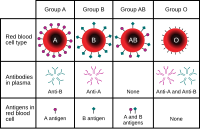
Photo from wikipedia
A term-born, Chinese male neonate was transferred to our hospital following detection of jaundice and anaemia 6 hours after birth. His haemoglobin concentration was 104 g/l with a red blood… Click to show full abstract
A term-born, Chinese male neonate was transferred to our hospital following detection of jaundice and anaemia 6 hours after birth. His haemoglobin concentration was 104 g/l with a red blood cell count (RBC) of 2 72 9 10/l and a robust compensatory haematological response: reticulocytes 7 72%, absolute reticulocyte count 218 5 9 10/l and reticulocyte production index 3 30 (normal range 0 2–1 5). A peripheral blood film showed spherocytes, polychromatic cells, occasional nucleated RBCs and red cell fragments (left panel, 9100 objective; Wright–Giemsa stain). His total bilirubin and indirect bilirubin concentrations were 202 2 lmol/l and 186 96 lmol/l respectively. The initial laboratory findings suggested haemolytic disease of the fetus and newborn (HDFN), so antiglobulin tests were performed. His blood group was typed as AB, Rh D-positive (top right). The direct antiglobulin test was positive with the neonatal red cells (middle right, C), and immunoglobulin G (IgG) anti-A and anti-B antibodies were detected in the neonatal plasma (middle right, A, B, O) and in the neonatal red cell eluate (middle right, A, B, O). No irregular blood group antibodies were detected (bottom right), confirming the diagnosis of ABO HDFN. After seven sessions of phototherapy, two doses of intravenous immunoglobulin and two transfusions of blood group O red cells, he remained clinically stable and was discharged on day 10. Nucleotide sequences revealed that he had A102 and B101 alleles. His biological mother was blood group B, but he was born to a group O, Rh D-positive surrogate mother, rendering ABO haemolytic disease in a blood group AB neonate possible. In contrast with O/B and O/A incompatibility, severe HDFN due to maternal IgG anti-A and anti-B antibodies in a blood group AB neonate is exceptional.
Journal Title: British Journal of Haematology
Year Published: 2020
Link to full text (if available)
Share on Social Media: Sign Up to like & get
recommendations!